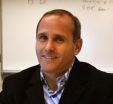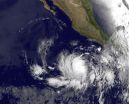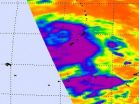(Press-News.org) The universe is a marvelously complex place, filled with galaxies and larger-scale structures that have evolved over its 13.7-billion-year history. Those began as small perturbations of matter that grew over time, like ripples in a pond, as the universe expanded. By observing the large-scale cosmic wrinkles now, we can learn about the initial conditions of the universe. But is now really the best time to look, or would we get better information billions of years into the future - or the past?
New calculations by Harvard theorist Avi Loeb show that the ideal time to study the cosmos was more than 13 billion years ago, just about 500 million years after the Big Bang. The farther into the future you go from that time, the more information you lose about the early universe.
"I'm glad to be a cosmologist at a cosmic time when we can still recover some of the clues about how the universe started," Loeb said.
Two competing processes define the best time to observe the cosmos. In the young universe the cosmic horizon is closer to you, so you see less. As the universe ages, you can see more of it because there's been time for light from more distant regions to travel to you. However, in the older and more evolved universe, matter has collapsed to make gravitationally bound objects. This "muddies the waters" of the cosmic pond, because you lose memory of initial conditions on small scales. The two effects counter each other - the first grows better as the second grows worse.
Loeb asked the question: When were viewing conditions optimal? He found that the best time to study cosmic perturbations was only 500 million years after the Big Bang.
This is also the era when the first stars and galaxies began to form. The timing is not coincidental. Since information about the early universe is lost when the first galaxies are made, the best time to view cosmic perturbations is right when stars began to form.
But it's not too late. Modern observers can still access this nascent era from a distance by using surveys designed to detect 21-cm radio emission from hydrogen gas at those early times. These radio waves take more than 13 billion years to reach us, so we can still see how the universe looked early on.
"21-centimeter surveys are our best hope," said Loeb. "By observing hydrogen at large distances, we can map how matter was distributed at the early times of interest."
The accelerating universe makes the picture bleak for future cosmologists. Because the expansion of the cosmos is accelerating, galaxies are being pushed beyond our horizon. Light that leaves those distant galaxies will never reach Earth in the far future. In addition, the scale of gravitationally unbound structures is growing larger and larger. Eventually they, too, will stretch beyond our horizon. Some time between 10 and 100 times the universe's current age, cosmologists will no longer be able to observe them.
"If we want to learn about the very early universe, we'd better look now before it is too late!" Loeb said.
### END
The older we get, the less we know (cosmologically)
2012-05-23
ELSE PRESS RELEASES FROM THIS DATE:
Psychological Science explains uproar over prostate-cancer screenings
2012-05-23
WASHINGTON— The uproar that began last year when the U.S. Preventive Services Task Force stated that doctors should no longer offer regular prostate-cancer tests to healthy men continued this week when the task force released their final report. Overall, they stuck to their guns, stating that a blood test commonly used to screen for prostate cancer, the PSA test, causes more harm than good — it leads men to receive unnecessary, and sometimes even dangerous, treatments.
But many people simply don't believe that the test is ineffective. Even faced with overwhelming evidence, ...
Array of light for early disease detection?
2012-05-23
A special feature in this week's issue of the journal Science highlights protein array technology, touching on research conducted by Joshua LaBaer, director of the Biodesign Institute's Virginia G. Piper Center for Personalized Diagnostics.
With the successful completion of the Human Genome Project, research attention is increasingly focusing on proteins. Versatile products produced from genetic templates, proteins are principle actors in both the maintenance of health and the onset of illness. Protein microarrays are a means of bridging the gap between analysis of the ...
NASA Sees Eastern Pacific's Second Tropical Storm Form
2012-05-23
On May 21, NASA satellites were monitoring Tropical Depression 02E in the eastern Pacific Ocean, and 24 hours later it strengthened into the second tropical storm of the season. Tropical Storm Bud was captured by NOAA's GOES-13 satellite on May 22, and appears to be well-formed.
Tropical Storm Bud isn't going to stop there, however. According to the forecasters at the National Hurricane Center, Bud is expected to become a hurricane because of light to moderate wind shear and warm sea surface temperatures.
On May 22 at 0900 UTC (2 a.m. PDT/5 a.m. EDT), Tropical Storm ...
NASA satellite sees Tropical Storm Sanvu pass Guam, strengthen
2012-05-23
Tropical Depression 03W in the western North Pacific did exactly what forecasters expected over the last twenty-four hours: it became a tropical storm named Sanvu and passed west of Guam on a northwesterly track.
On May 22 at 0900 UTC (5 a.m. EDT), Tropical Storm Sanvu was more than 100 miles west-northwest of Andersen Air Force Base, Guam, and still over 600 nautical miles south of Iwo To, Japan and headed in that direction. Sanvu's center was located near 15.2 North and 141.9. East. It was still churning up rough surf around Guam. Sanvu has maximum sustained winds near ...
Barrow researchers use magic for discoveries
2012-05-23
(Phoenix, AZ May 22, 2012) -- Researchers at Barrow Neurological Institute at St. Joseph's Hospital and Medical Center have unveiled how and why the public perceives some magic tricks in recent studies that could have real-world implications in military tactics, marketing and sports.
Susana Martinez-Conde, PhD, of Barrow's Laboratory of Visual Neuroscience, and Stephen Macknik, PhD, of Barrow's Laboratory of Behavioral Neurophysiology are well known for their research into magic and illusions. Their most recent original research projects, published in Frontiers in Human ...
Alberto now a tropical depression, seen by NASA
2012-05-23
Infrared satellite imagery from NASA's Aqua satellite revealed Alberto weakened from a tropical storm to a tropical depression as it appears more disorganized. At 10:30 a.m. EDT on May 21, Tropical Storm Alberto weakened to a tropical depression, and has maintained that status today, May 22.
As of 5 a.m. EDT on May 22, Alberto's maximum sustained winds were near 35 mph (55 kph) but he is expected to weaken in 24 hours. Alberto was centered about 220 miles south of Cape Hatteras, North Carolina, near 32.0 North and 75.5 West. Alberto was moving to the northeast near 15 ...
Cleft lip/palate cause much more than cosmetic problems
2012-05-23
MAYWOOD, Ill. -- Children born with cleft lip, cleft palate and other craniofacial disorders face numerous medical challenges beyond appearance.
Patients can face serious airway, feeding, speech and hearing problems, as well as social and psychological challenges, Laura Swibel Rosenthal, MD, of Loyola University Medical Center and colleagues write in the June 2012 issue of Otolaryngologic Clinics of North America.
"The management of patients with craniofacial syndromes is complex," Rosenthal and colleagues write. "Otolaryngologic [ear-nose-throat] evaluation is of paramount ...
Scientists start explaining Fat Bastard's vicious cycle
2012-05-23
This press release is available in French.
VIDEO:
Stephanie Fulton of Université de Montréal and its affiliated research hospital studies the behavior of mice and their brain chemistry to reveal how humans may act in similar circumstances.
Click here for more information.
Fat Bastard's revelation "I eat because I'm depressed and I'm depressed because I eat" in the Austin Powers ...
Weight loss improves SBD and metabolic dysregulation in obese children
2012-05-23
ATS 2012, SAN FRANCISCO –Weight loss improved both metabolic parameters and sleep-disordered breathing (SDB) in obese children in a new study from researchers in Belgium, confirming links between metabolic dysregulation, SDB and obesity.
"SDB is highly prevalent in childhood obesity, and may be a risk factor for the metabolic syndrome. In our population of 224 obese children and adolescents, 30% had SDB, which was significantly correlated with metabolic parameters, including aspartate aminotransferase (ASAT), alanine aminotransferase (ALAT) and HDL cholesterol at baseline," ...
Severity of sleep disordered breathing predicts glycemic health
2012-05-23
ATS 2012, SAN FRANCISCO –The severity of sleep disordered breathing and nocturnal hypoxemia independently predict both glycosylated hemoglobin (HbA1c) levels and type 2 diabetes mellitus (T2DM), according to a new study.
"Because people with obstructive sleep apnea syndrome (OSAS) are often overweight or obese it has been difficult to interpret earlier studies of the relationship between sleep disordered breathing and metabolic disorders," said Brian Kent, MBBCh, research fellow at St. Vincent's University Hospital in Dublin. "We found that obstructive sleep apnea syndrome ...



